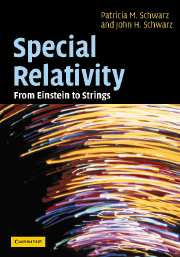Book contents
- Frontmatter
- Contents
- Preface
- Part I Fundamentals
- Part II Advanced Topics
- 7 When quantum mechanics and relativity collide
- 8 Group theory and relativity
- 9 Supersymmetry and superspace
- 10 Looking onward
- Appendix 1 Where do equations of motion come from?
- Appendix 2 Basic group theory
- Appendix 3 Lie groups and Lie algebras
- Appendix 4 The structure of super Lie algebras
- References
- Index
8 - Group theory and relativity
Published online by Cambridge University Press: 06 July 2010
- Frontmatter
- Contents
- Preface
- Part I Fundamentals
- Part II Advanced Topics
- 7 When quantum mechanics and relativity collide
- 8 Group theory and relativity
- 9 Supersymmetry and superspace
- 10 Looking onward
- Appendix 1 Where do equations of motion come from?
- Appendix 2 Basic group theory
- Appendix 3 Lie groups and Lie algebras
- Appendix 4 The structure of super Lie algebras
- References
- Index
Summary
In previous chapters we have encountered frequently the concept of symmetry of physical laws and symmetry of physical systems under mathematical or physical transformations. The primary examples of symmetry transformations that we have encountered were spatial rotations and Lorentz transformations. The concept of symmetry is very important in physics, not only in the context of transformations of space and time, but also in many others. As it happens, there is a beautiful branch of mathematics, called group theory, which is ideally suited to the description of symmetry. The application of group theory to physics, especially in the context of quantum mechanics, was worked out by Wigner, Weyl, and others in the 1920s and 1930s. By now it is part of the standard toolkit of an educated physicist. This chapter will introduce basic group theory with an emphasis on the application to the descriptions of rotational symmetry and Lorentz symmetry, which are the examples of greatest relevance here.
What is a group?
Rotations and Lorentz transformations are examples of transformations that one can imagine applying to physical objects, collections of objects, systems of equations (the Maxwell equations, for example), or even the entire Universe. When they are symmetries of the system in question, as in the case of the Maxwell equations, the transformed system is identical to the original one. However, it is also possible to transform a system that does not possess the symmetry, in which case the transformed system looks different from the original one.
- Type
- Chapter
- Information
- Special RelativityFrom Einstein to Strings, pp. 260 - 286Publisher: Cambridge University PressPrint publication year: 2004

